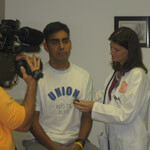
San Antonio firefighter Rob Gonzales was only 200 yards from the back of his station, No. 11 at Leona and El Paso streets, when the SUV made a U-turn in front of his motorcycle. He laid the bike down to avoid collision but then was run over. He suffered a lacerated spleen, severe concussion, broken leg and other injuries – including a small tear in the lining of his thoracic aorta.
During 33 days at Wilford Hall Medical Center, Gonzales was not well enough for surgeons to open his chest to fix the aorta. The team stabilized his other injuries first.
A plan developed for correcting the problem in a minimally invasive way, making use of the expertise of a newly recruited faculty member in the division of vascular surgery at the Health Science Center. Maureen Sheehan, M.D., brought with her a repair technique called a thoracic endograft.
A thoracic endograft surgery was performed Aug. 22 at the Health Science Center’s teaching hospital, University Hospital. It was Dr. Sheehan’s first day on the job. She performed the surgery with Todd Rasmussen, M.D., chief of vascular surgery at Wilford Hall and clinical associate professor of surgery at the Health Science Center.
This is the first thoracic endograft surgery ever performed in San Antonio.
An endograft is a covered stent placed inside an artery to take pressure off an aneurysm or repair a damaged wall. The surgeons used the first FDA-approved device for thoracic endografts.
Dr. Sheehan learned the procedure at the University of Pittsburgh, where she did her vascular surgery fellowship. To ensure the best outcome for Gonzales, the surgical team waited about 10 days until her arrival.
In the traditional surgery, the chest is cracked open. This may be followed by complications such as pneumonia. The new surgery reduces the chance of complications, hospital stay and recovery time. Gonzales, 39, went home the day after his surgery. “Basically, the key for me was the time to recover,” he said. “I want to get back to my usual self as quickly as possible.”
The vascular surgeons made a 1-inch incision in the right groin to insert a catheter containing the stent. They threaded the catheter through the femoral artery into the thoracic aorta. The aorta requires a larger stent than those used in other blood vessels.
“At the time of operation, everything looked good,” Dr. Sheehan said. “We were able to deploy the stent in the appropriate place and the damaged part of the artery was excluded from blood flow.” Without surgery, the damaged area of the aorta would have formed an aneurysm or bulging area. As an aneurysm enlarges, possibility of rupture increases and survival chance decreases.
“Historically we would open the chest with the patient asleep and move the lungs out of the way and/or deflate them to get to the aortic injury,” Dr. Rasmussen said. “The patient would have to be put on some sort of bypass and the aorta would be clamped above and below the injury. Then that part of the aorta would be cut out and a new prosthetic fabric graft would be sewn at the site.
“The stress of that operation on the patient is considerable and typically results in a seven- to 10-day stay in the hospital, including three or four days in the ICU, and six weeks to full recovery. That’s in an optimal situation,” Dr. Rasmussen said.
The new catheter-based technologies allow surgeons to go inside the aorta and place a covered self-expanding stent (which is squeezed down to the size of a pencil) and pops out to the size of the aorta. Surgeons land the graft above the aneurysm where the aorta is normal and it forms a bridge to below the aneurysm where the aorta is normal. That seals the aorta and allows the aneurysm to heal. It is meant to be there forever.
The stent Gonzales received is a self-expanding metal that is covered with a thin plastic material called ePTFE (expanded polytetrafluoroethylene).
Vascular surgery is in a new era in San Antonio, Dr. Rasmussen said. The Health Science Center, University Hospital and the military have established an integrated vascular practice.
“The arrival of Dr. Sheehan complements an outstanding team of young surgeons capable of managing complex diseases of the abdominal and thoracic aorta,” Dr. Rasmussen said. “San Antonio patients do not have to go to other cities for the complex cases. They have the best care right here.”
The group is able to offer expert treatment of aortic aneurysm disease related to aging and atherosclerosis. “The new surgeons not only augment the trauma system in San Antonio, but they can treat your grandpa or grandma who before might have died of a ruptured aortic aneurysm within six months of detection,” Dr. Rasmussen said.
“This sort of integration with the university enhances our ability to care for wartime injuries,” he said. “We are pushing to have some of these new catheter-based technologies available for our injured troops in Iraq or Afghanistan. Our goal is to take parts of this technology to the in-theater management of wartime vascular injury. We are more likely to succeed if we grow in an academic vascular surgery practice such as has been established here in San Antonio.”
Gonzales wasn’t on the battlefield, but he was in the same kind of desperate need. He has seen many such situations before, as his fire house is involved in trench, structural-collapse, swift-water, cave, haz-mat, and high- and low-angle rescues. The new surgery completes an amazing summer of health care that will enable him to return to his family and career.

